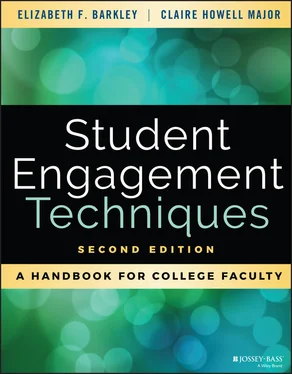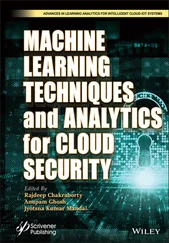Elizabeth F. Barkley - Student Engagement Techniques
Здесь есть возможность читать онлайн «Elizabeth F. Barkley - Student Engagement Techniques» — ознакомительный отрывок электронной книги совершенно бесплатно, а после прочтения отрывка купить полную версию. В некоторых случаях можно слушать аудио, скачать через торрент в формате fb2 и присутствует краткое содержание. Жанр: unrecognised, на английском языке. Описание произведения, (предисловие) а так же отзывы посетителей доступны на портале библиотеки ЛибКат.
- Название:Student Engagement Techniques
- Автор:
- Жанр:
- Год:неизвестен
- ISBN:нет данных
- Рейтинг книги:3 / 5. Голосов: 1
-
Избранное:Добавить в избранное
- Отзывы:
-
Ваша оценка:
- 60
- 1
- 2
- 3
- 4
- 5
Student Engagement Techniques: краткое содержание, описание и аннотация
Предлагаем к чтению аннотацию, описание, краткое содержание или предисловие (зависит от того, что написал сам автор книги «Student Engagement Techniques»). Если вы не нашли необходимую информацию о книге — напишите в комментариях, мы постараемся отыскать её.
— — — —
Student Engagement Techniques
"Student Engagement Techniques
"Student Engagement Techniques
"This book is an essential resource for faculty seeking to better engage with their students. Anyone seeking a clear, research-based, and actionable guide needs a copy of Student Engagement Techniques on their shelf!"
Student Engagement Techniques — читать онлайн ознакомительный отрывок
Ниже представлен текст книги, разбитый по страницам. Система сохранения места последней прочитанной страницы, позволяет с удобством читать онлайн бесплатно книгу «Student Engagement Techniques», без необходимости каждый раз заново искать на чём Вы остановились. Поставьте закладку, и сможете в любой момент перейти на страницу, на которой закончили чтение.
Интервал:
Закладка:
Table of Contents
1 Cover
2 Preface Preface TEACHERS IN INSTITUTIONS across the country tell us that teaching today can be tough. The “twitch speed” pace and multilayered delivery of modern media can make a lecture feel so incredibly slow and boring, one student reported all the blood had left his head and he feared he'd pass out (El-Shamy, 2004, p. 24). Globalization and open-door access have filled our classrooms with learners reflecting such a dizzying array of backgrounds and academic preparedness that teachers are often hard-pressed to find a collective starting point or the commonalities that create a sense of community. Abundant information that can be accessed at split-second speed has redefined what students should be learning and created unprecedented opportunities for academic dishonesty. A panoply of pressures make some classrooms a crucible of tensions that can erupt in incivility ranging from simple lack of consideration to overt aggression. For many of us teaching today, competing for the attention of our students and engaging them in meaningful learning is a profound and ongoing challenge. But, there is a flipside. Even if college teachers did have the performance skills and production support to put on a show that matches the level of sheer sensory stimulation supplied by today's video and computer games, music videos, films, and television shows, it wouldn't matter—engaging students doesn't mean entertaining them. It means they are thinking and investing emotional and mental energy in their work. Although the diversity of today's students can be a challenge, it also means students are bringing a rich array of experiences, insights, and ideas to their learning. The information and communication revolution can make our roles much more interesting than being mere dispensers of information. And finally, perhaps we can teach students—particularly those with short fuses—how to resolve conflicts in ways that can contribute to a happier, safer future.
3 Acknowledgments Acknowledgments WE ARE DEEPLY indebted to Thomas A. Angelo and K. Patricia Cross for their seminal work in creating the prototype for this handbook with Classroom Assessment Techniques: A Handbook for College Teachers (Jossey-Bass 1993). Through the years, we have worked with K. Patricia Cross, and we used the classroom assessment techniques (CATs) structure for our books in the college teaching techniques series. Pat's writing and thinking have left an indelible imprint throughout this current work. Our decision to dedicate the book to her is rooted in immense gratitude for her inspirational guidance. For the first edition of this book, numerous people gave support, insightful comments, and constructive criticism, including David Brightman, Jessica Egbert, and Aneesa Davenport at Jossey-Bass. Others, from a variety of affiliations, included James Rhem, Jillian Kinzie, Kay McClenney, L. Dee Fink, Judith Ouimet, Robert Smallwood, Maryellen Weimer, and members of Elizabeth's Instructional Team—Robert Hartwell, Milissa Carey, and Baomi Watson. In this second edition, Elizabeth invited Claire to collaborate, as we have done with three other books in Wiley's Jossey-Bass College Teaching Techniques Series: Collaborative Learning Techniques, Learning Assessment Techniques, and Interactive Lecturing Techniques . For the second edition of this book, we offer our thanks to Robyn Hammontree for her excellent contributions on how to implement these techniques online. We also thank Liz Johnson, for sharing her knowledge of STEM and providing us with her insights about how these techniques are used in this increasingly important area. And we thank Matt Fifolt for his suggestions for the manuscript. Finally, to our husbands, Eric and Ted, we offer our deepest, heartfelt gratitude for their ongoing support and understanding.
4 Part One: A Conceptual Framework for Understanding Student Engagement Part One A Conceptual Framework for Understanding Student Engagement
Chapter 1: What Does “Student Engagement” Mean? About the Term A Model of Student Engagement Conclusion Chapter 2: Engagement and Motivation What Is Motivation? What Motivates Students? How Are Students Motivated? Expectancy-Value Theory Temporal Motivation Synthesis of Motivation Theories Conclusion Chapter 3: Engagement and Active Learning What Is Learning? What Factors Influence Learning? What Is Active Learning? What Are Active Learning Techniques? The Relationship Between Active Learning and Active Learning Techniques Conclusion Chapter 4: Promoting Synergy Between Motivation and Active Learning Condition 1: Teachers Can Promote Synergy by Creating a Sense of Classroom Community Condition 2: Teachers Can Create Synergy by Helping Students Work at Their Optimal Level of Challenge Condition 3: Teachers Can Create Synergy by Teaching so That Students Learn Holistically Putting It All Together: The Engagement Process Conclusion
5 Part Two: Tips and Strategies Chapter 5: Tips and Strategies for Fostering Motivation T/S 1 Expect Engagement T/S 2 Develop and Display the Qualities of Engaging Teachers T/S 3 Reward Learning Rather Than Behavior T/S 4 Use Praise and Criticism Effectively T/S 5 Attend to Students' Basic Needs so That They Can Focus on the Higher-Level Needs Required for Learning T/S 6 Promote Student Autonomy T/S 7 Teach Things Worth Learning T/S 8 Integrate Goals, Activities, and Assessment T/S 9: Craft Engaging Learning Tasks T/S 10: Incorporate Competition Appropriately T/S 11: Expect Students to Succeed T/S 12 Help Students Expect to Succeed T/S 13: Try to Rebuild the Confidence of Discouraged and Disengaged Students Chapter 6: Tips and Strategies for Promoting Active Learning T/S 14 Be Clear on Your Learning Goals T/S 15 Clarify Your Role T/S 16 Orient Students to Their New Roles T/S 17 Help Students Develop Learning Strategies T/S 18: Activate Prior Learning T/S 19 Teach in Ways That Promote Effective Transfer T/S 20 Teach for Retention T/S 21 Limit and Chunk Information T/S 22 Provide Opportunities for Guided Practice and Rehearsal T/S 23 Organize Lectures in Ways That Promote Active Learning T/S 24 Use Flipped, Reverse, or Inverted Classroom Organization T/S 25 Use Rubrics to Give Learners Frequent and Useful Feedback Chapter 7: Tips and Strategies for Building Community T/S 26 Move Away from an Authoritarian Role T/S 27 Plan for Promoting Class Civility T/S 28 Create a Physical or Online Course EnvironmentThat Supports Community T/S 29 Reduce Anonymity: Learn Students' Names and Help Students Learn Each Other's Names T/S 30 Use Icebreakers as a Class Warm-Up T/S 31 Use Technology to Extend or Reinforce Community T/S 32 Be Consciously Inclusive T/S 33 Subdivide Large Classes into Smaller Groupings T/S 34 Involve All Students in Discussion T/S 35 Use Group Work Effectively T/S 36 Use Intermissions T/S 37 Celebrate Community Chapter 8: Tips and Strategies to Ensure Students Are Challenged Appropriately T/S 38 Assess Students' Starting Points T/S 39 Monitor Class Pacing T/S 40 Help Students Learn to Self-Assess T/S 41 Differentiate Course Elements to Meet Individual Student Needs T/S 42 Use Scaffolding to Provide Assistance for Complex Learning Chapter 9: Tips and Strategies to Promote Holistic Learning T/S 43 Pick Up the Pace to Hold Attention T/S 44 Offer Options for Nonlinear Learning T/S 45 Use Principles of Universal Design T/S 46 Incorporate Games T/S 47 Teach so That Students Use Multiple Processing Modes T/S 48 Incorporate Multiple Domains When Identifying Learning Goals T/S 49 Include Learning Activities That Involve Physical Movement T/S 50 Consider Creating a “Graphic Syllabus”
6 Part Three: Student Engagement Techniques (SETs) Techniques to Engage Students in Learning Course-Related Knowledge and Skills Chapter 10: Knowledge, Skills, Recall, and Understanding STUDENT ENGAGEMENT TECHNIQUE
Читать дальшеИнтервал:
Закладка:
Похожие книги на «Student Engagement Techniques»
Представляем Вашему вниманию похожие книги на «Student Engagement Techniques» списком для выбора. Мы отобрали схожую по названию и смыслу литературу в надежде предоставить читателям больше вариантов отыскать новые, интересные, ещё непрочитанные произведения.
Обсуждение, отзывы о книге «Student Engagement Techniques» и просто собственные мнения читателей. Оставьте ваши комментарии, напишите, что Вы думаете о произведении, его смысле или главных героях. Укажите что конкретно понравилось, а что нет, и почему Вы так считаете.












